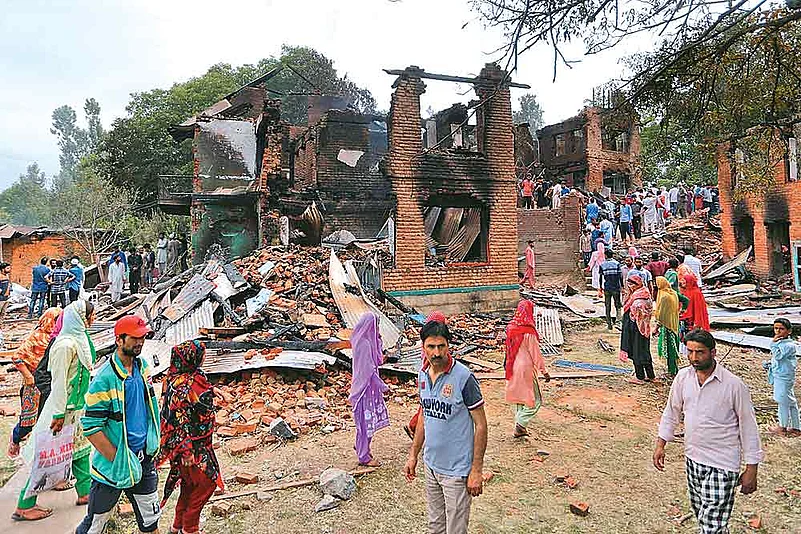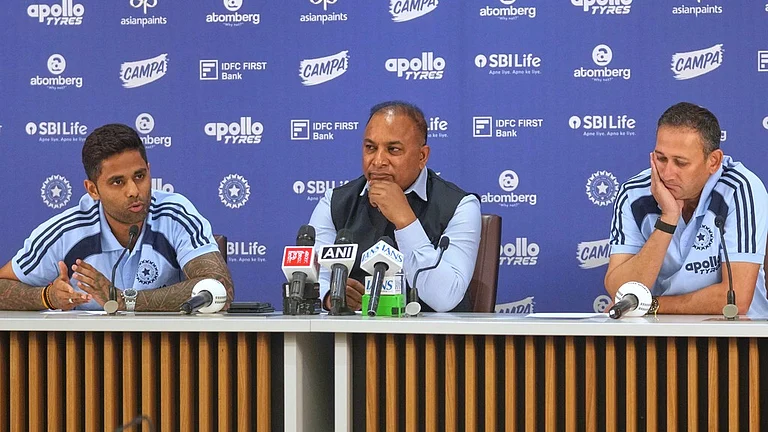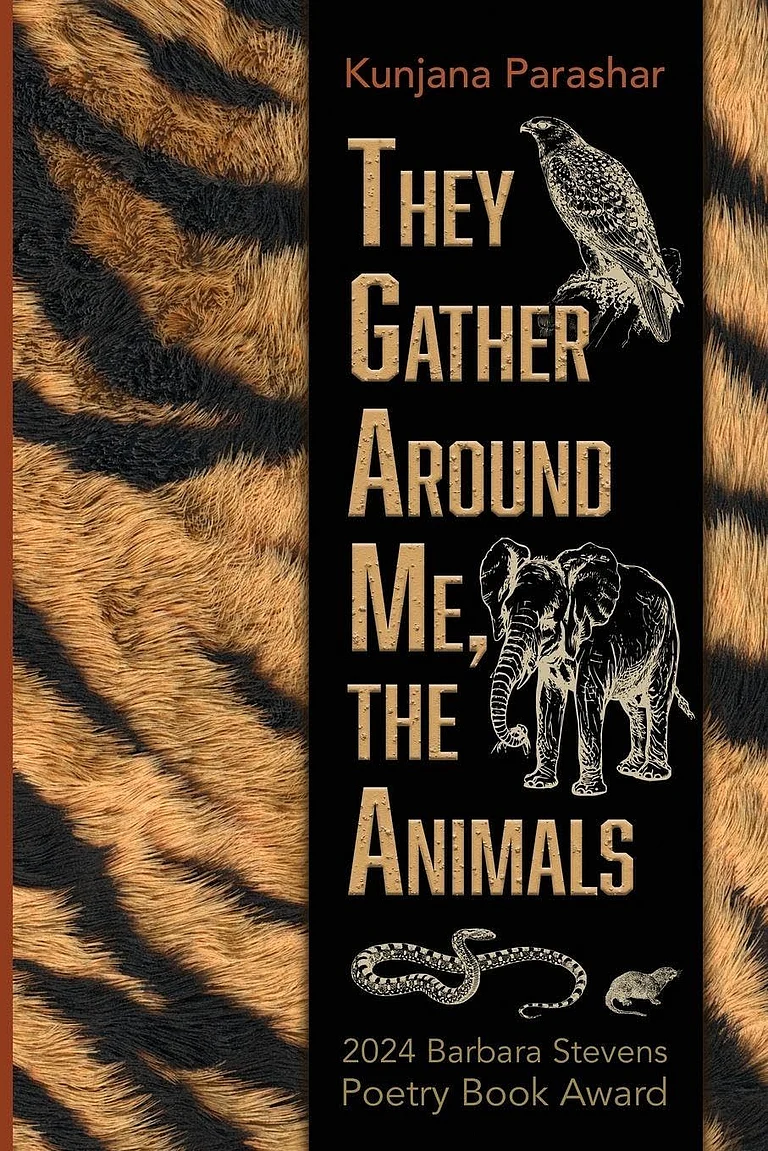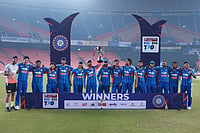A t the martyrs’ graveyard in south Kashmir’s Tral town, two boys stood silently by the grave of Burhan Wani, the 22-year-old who was killed by government forces in an encounter on July 8 last year in Kokernag. The boys, seventh-grade students at the local government school, raise their hands and pray for Burhan. Then they move aside and talk about the “healing power” of the soil of his grave. “People from far and wide come here and take handfuls of this soil,” says one of them. “They believe it can cure disease. My ailing mother asked me to get some soil from Burhan’s grave. She rubbed it on her face and instantly felt much better.”
Burhan’s engraved memorial plaque stands out, visible from quite a distance, in this graveyard where more than 50 militants slain by government forces are buried. Most are locals. People come here to pray for their “martyrs”. Some take away a handful of soil from Burhan’s grave. Clearly, everything about Burhan is sacred to them.
_201707.jpg?w=801&auto=format%2Ccompress&fit=max&format=webp&dpr=1.0)
Sajad Ahmad, a 25-year-old driver standing nearby, overhears the boys’ conversation. “There are always visitors at Burhan’s grave and the crowds will swell in the days ahead,” Sajad says. All three, however, refuse to be photographed—quite unthinkable in these parts a year ago, when people poured into the streets on hearing “Burhan killed!” and scores of pictures of people mourning the slain Hizbul commander flooded the internet. So why this newfound reticence?
Schoolboy Numan is quick with the reason: “The STF (Special Task Force, a counter-insurgency formation of the Jammu and Kashmir Police) will arrest us and beat us ruthlessly. We don’t mind being beaten by the STF if that could bring us azadi (freedom), but why get thrashed when azadi isn’t just around the corner?”
With the army, paramilitary forces going all out against militants and protesters, it’s back to alleged human rights abuses and frequent frisking by security agencies. The number of armed personnel has gone up visibly in the past month. Across the Valley—from uptown Srinagar to south Kashmir villages—there are a lot more army patrols on the roads than a few weeks ago. The frequency of raids on villages has also gone up. No wonder the driver and the two schoolboys are so serious about protecting their identities.
When Burhan joined the militancy in 2010, there were only three militants in Tral. His breakthrough move was to take to social media, ending the period when militants were a mysterious lot, spoken about by others, with their image largely based on how others—especially their adversaries—described them. Unsurprisingly, this change led to a surge in young men lining up to join militant ranks—so many that, say sources, many had to be turned back as the number of aspiring militants far outstripped the number of available weapons. These youngsters were told to arm themselves first, by snatching weapons from policemen and paramilitary personnel. “They ask new recruits to kill a cop or a paramilitary jawan to get his weapon. This way the militants get weapons as well as a recruit who cannot return to civilian life even if he wants to,” says a senior police official.
In the past few weeks, faced with denser deployment of government forces in the rural areas, residents of places like Tral have learnt to be cautious about what to tell whom. For instance, a shopkeeper curtly dismisses Outlook saying, “Why should we tell you what we plan to do on Burhan’s anniversary?” Many others simply refused to talk or be photographed. The youngsters say a large number of locals have been arrested and have cases slapped on them, or are regularly summoned to the police stations. “That’s why most people won’t talk with you,” says Sajjad, at the graveyard. “There are 16 FIRs against me. Why should I let you take my picture and get named in another FIR?”
A retired teacher, who agrees to talk after much prodding, says, “Burhan is a militant icon who emerged in Kashmir alongside India’s fall from a secular occupation to a Hindu-fascist one.” Burhan’s popular appeal, he says, reflects the “infamy of Indian State and the total rejection of pro-India politics in Kashmir”. “He may be dead today, but equally dead is India’s future in Kashmir,” he says, mincing no words. “Burhan might be the last Kashmiri who was killed while there still remained some doubt in his and his people’s mind about whether India would ever leave Kashmir. After his death, there is a clear consensus that India has lost its case in Kashmir.”
In all these months, however, despite the killing of Burhan’s successor Sabzar Ahmad Bhat and two of his two associates, Tral has been relatively peaceful, with no major student protest, unlike elsewhere in the Valley.
Senior police officials concede that Burhan’s use of social media to revive popular interest in militancy was quite a hit, especially in south Kashmir. “it was great propaganda and enhanced his appeal among ideologically committed youngsters,” says an officer. “But it cuts both ways as not only supporters but also the intelligence agencies get to know much about the militants. The same method that helps them become popular and find recruits also helps us target them at the time and day of our choosing. In fact, militancy has been sustained in Kashmir for so long because of secrecy. I remember how tough it was to find even a single photograph of Hizbul militants of the previous generation.”
Sitting in his house opposite the Sufi shrine of Shariabad, Burhan’s father, Muzaffer Wani, principal at a government school, says there hasn’t been a single day since Burhan’s death when people from different areas of Jammu and Kashmir did not visit his house. “They say they just want to see where Burhan lived. Some take pictures with me and leave,” says Muzaffer, and then recalls how Burhan’s 25-year-old brother Khalid was beaten to death by the army and later branded as a militant. “Even the police refused to accept the army’s version that he was militant.” On April 13, 2015, Khalid’s body was found in the Buchoo forest of Tral. The army claimed he was an “overground militant” killed during a gunfight. His father is sure that Khalid was killed in cold blood.

Soldiers celebrate after killing militants
Naming several youngsters from Tral, who became militants because of the atrocities perpetrated on them and their families by the police and other government forces, Muzaffar holds the forces squarely responsible for the growing militancy in Kashmir. “They harassed even distant relatives of militants, forcing them to take up arms,” he says.
Away from serene Tral, in Nagbal-Tengpuna area of Pulwama, Abdul Qayoom Wani, is mourning the killing of his nephew Touseef. On June 22, the 22-year-old was killed by the Special Operation Group (SOG) of J&K Police at Kakpora, around 15 km from Nagbal. “This happened a day after the Kakpora encounter in which three Lashkar-e-Toiba militants were killed. If Touseef was protesting or even throwing stones, they could have wounded him. But, no, they killed him,” says Qayoom. “The police named him Chhota Geelani, as he had been jailed twice for stone-pelting, to justify his brutal murder.” Government forces allegedly thrashed the villagers and damaged their vehicles when they were bringing Touseef’s body to the village. “We will never forget all this,” says Qayoom. “I didn’t file any FIR in the case because I don’t expect any justice from this system. My nephew was shot in the neck. We didn’t even go for the post-mortem.”
According to a police spokesman, “a violent mob attacked the Kakpora police post , after the burial of the Lashkar militants and Touseef was killed in retaliatory action”. Twenty-two civilians have been killed near encounter sites this year—the highest number in recent years.
A small lane leads towards New Colony in Kakpora where an elderly Abdul Bhat and his two sons are standing beside heaps of bricks and dirt that once used to be his three-storey house. “On June 21, three militants came here after they were chased by the army. I was in hospital with one of my daughters. We didn’t know the militants had entered our house. We saw only their charred bodies,” says Bhat, who has filed no FIR and expects no compensation. Neighbours say the house was blasted several times during the night. Even the trees around it were burnt. “The militants burnt in the fire. There were no bodies, just burnt skeletons,” says a woman.

Villagers mourn a militant’s death
Since July 21, around 15 militants have been killed in a new counter-offensive against the militants. Two Lashkar militants, including commander Bashir Lashkari, were killed on July 1 at Batpora village in south Kashmir. According to the police, Bashir was involved in the killing of six policemen, including an SHO, in an ambush last month. Minutes after his killing, SSP Imtiyaz Hussain, posted in north Kashmir, tweeted, “RIP Feroz. Justice delivered. Wish good sense prevails & there are no more killings in Kashmir and we all live in peace.”
In Srinagar, rights activists such as Khurram Parvez say the situation is alarming as the armed forces are being “pushed by the media and social media frenzy, whipped up by right-wing elements, to punish the people of Kashmir”. “There is increasing public support in India for blinding or maiming protesters, use of civilians as human shields, extra-judicial executions and torture,” says Khurram.
PDP youth president Waheed-ur-Rehman Parra, however, says that 60 per cent of J&K’s population comprises the youth. “They have political aspirations and some of them see dignity in death. We must understand that it is a political, social and emotional problem. We all need to find a solution,” he says. Admitting that the police station is only interface between the government and the youths, as they are regularly called for questioning, he says, “This must change.” The only visible “change” on the ground, however, is a tighter security network to prevent the kind of protests that had broken out last year after Burhan’s killing.
***
Line Of Fire
- June 21 Two local Hizbul militants, including a district commander, killed in an encounter with government forces forces in Pazalpora, Sopore
- June 22 Three local Lashkar militants killed in Kakpora, Pulwama
- June 22 Foreign militant killed as army foils infiltration bid in Keran
- June 23 DSP lynched by mob outside Jamia mosque in Srinagar
- June 24 A CRPF sub-inspector killed in a militant ambush at Pantha Chowk; militants take refuge in Delhi Public School (DPS)
- June 25 Two Pakistani militants involved in killing of CRPF officer killed in a gunfight at DPS
- July 1 Two Lashkar-e-Toiba militants, including commander Bashir Lashkari, killed in a gunfight in Anantnag; two protesters were also killed near the encounter site
- July 4 Four Hizbul militants killed in Pulwama
By Naseer Ganai in Tral and Pulwama


























